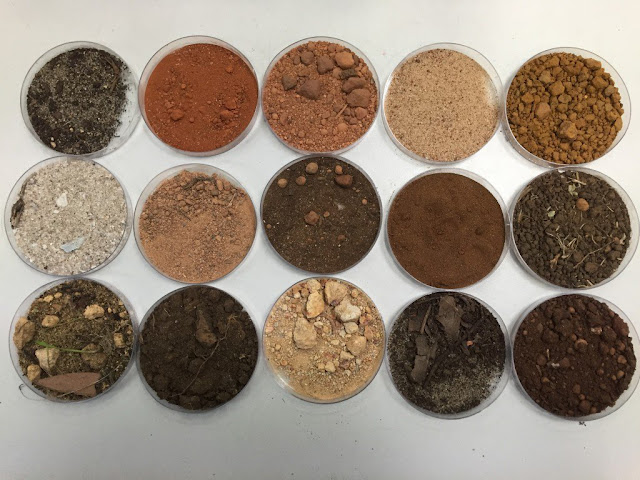Relationship between soil color and climate
 |
| Samples of soil from different places |
What is the first color that comes to mind when you envision soil? Is it brown, black, yellow, or red? How about white, gray, green, or blue? Any of these answers are correct depending on where you are from! It is true; soils come in an incredible range of colors.
Several forces, which soil scientists call the ?factors of soil formation?, influence soil color. These include climate, parent material (sediment or rock that soil forms in), biology, landscape position, time that a soil body has been forming, and human activity. Scientists document color when studying soils, as it clues them in to how soils may have formed. Color is also a good tool for determining the physical characteristics of soil.
What is responsible for soils? overall color? The amount of organic matter ? decomposed plant litter for example ? and soil moisture affects soil color. So does the presence or absence of minerals (e.g. carbonates, salts, and rusts). So much influences soil color, though we could argue that climate is one of the most important.
Why is climate so important when talking about soil color? Climate greatly dictates where and how quickly various organisms can grow. This, in turn, influences the rate at which soil organic matter develops. Climate also controls the amount of precipitation that moves through the soil system, as well as the amount of water that evaporates from the soil surface. Finally, climate influences the weathering rates of soil minerals, as well as their presence and location within the soil profile.
How then, does soil color differ across climatic zones?
Areas that are cool and wet, like the tundra of Northern Canada and Siberia generally have black, dark brown, and gray colored soils. Organic matter slowly builds in these regions of the world because there is adequate moisture to support plant life. When soil organisms die in these areas, the relatively cold temperatures limit the speed at which microbes decompose organic material. This build-up of organic matter is responsible for the dark brown and black soil colors.
Cold temperatures also limit the amount of water that evaporates from the soil. Because of this, soils in these regions are often very wet and tend to have very little available oxygen in them. In order for microbes to thrive, most need oxygen. Starved of atmospheric oxygen, the microbes use other oxygen sources in the soils, such as iron and manganese oxides (rusts). When the microbes use oxygen from these sources, they turn the iron and manganese oxides from red, yellow, and purple colors to gray, blue, and or green.
Soil microbes use oxygen from iron and manganese oxides occurs in wet soils throughout the globe, not just in cool climates! It is probably a good bet that if you are digging in and around a wetland, you will be able to find gray, blue, or even green colored soils.
The color of soils within deserts and other arid regions of the world can range from red, yellow/tan, to white. Color in dry areas is mostly influenced by parent material, as the lack of soil moisture limits plant growth and, in turn, the build up of organic matter. In many cases, any precipitation that falls to the soil surface quickly evaporates back into the atmosphere. When evaporation exceeds precipitation, dissolved salt and carbonate minerals are pulled towards the soil surface, which gives arid soils a white or pale value.
Soils in tropical environments are known for their bright red, orange, and brown colors. Plants grow very rapidly in these areas because of warm temperatures and plenty of rain. Overall though, tropical soils do not have very much organic matter (unless they are wet) because warm temperatures allow microbes to eat and decompose plant and animal material very quickly. The rusty colors associated with tropical soils are directly related to the presence of aluminum and iron oxides, which are a product of excessive chemical weathering via heat and precipitation.
You do not need to be a professional soil scientist to appreciate climate and its influence on soil color! If anything, noticing the color of soil as you visit different places can give you a greater connection to new and different environments. Next time you travel, I dare you to search for new and interesting soil colors. It will definitely make a long car or airplane ride much more fun.
The above post is reprinted from materials provided by Soil Science Society of America (SSSA).